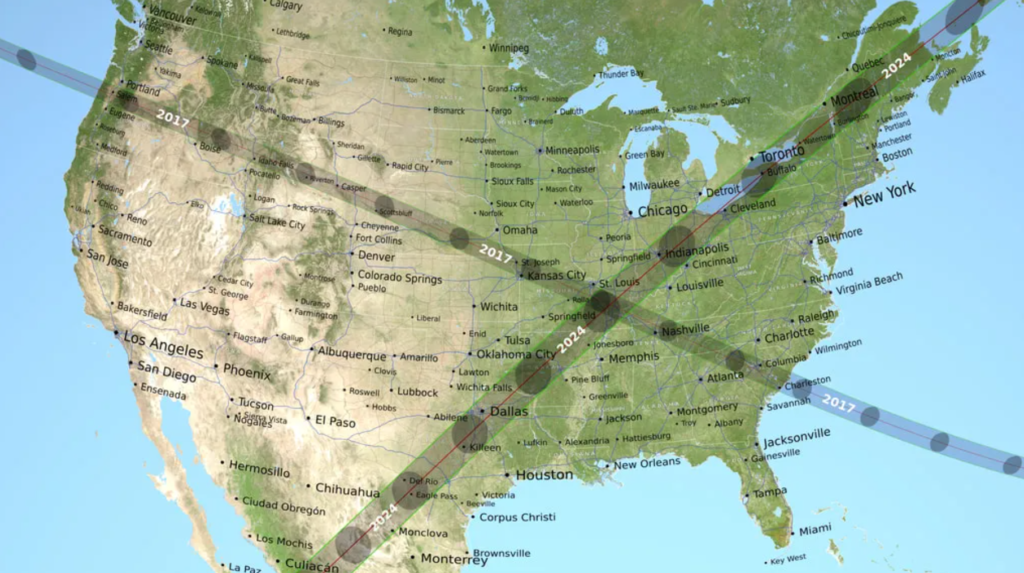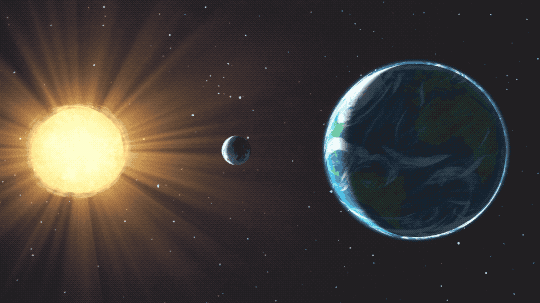Exciting news for science lovers, on April 8, 2024, a total solar eclipse will be visible in 15 states. This is the first time this has happened since 2017 and will be the last until 2033. Incredibly, it will also last for longer than the one in 2017, at more than 4 minutes in some places.
Where the Total Solar Eclipse will be

A total solar eclipse will take place later this year and will be visible all-over North America. In, fact as much as 99% of the population will have a chance to view the show. However, it will only be a partial solar eclipse. The total solar eclipse will be visible in Texas and Oklahoma, spanning to New York, Vermont, New Hampshire, and Maine. As well as Arkansas, Missouri, Illinois, Kentucky, Tennessee, Michigan, Indiana, Ohio, and Pennsylvania. Some of the U.S. cities that will have the most visibility include San Antonio, Dallas-Fort Worth, and Austin, as well as Indianapolis.
Parts of Mexico and Canada will also have a chance at viewing the total solar eclipse. Some southern areas include Durango, Chihuahua, Sinaloa, Nayarit, and Coahuila. Meanwhile, farther North, Ontario, Quebec, New Brunswick, Prince Edward Island, Nova Scotia and Newfoundland will get a chance to view the total solar eclipse. An estimated range of 115 miles wide, and 10,000 mile long, is the “path of totality”.
Expert Total Solar Eclipse Tracker
“The closer you are to the center, the more duration you get because the shadow is round,” said Dan McGlaun said, a solar eclipse tracker and founder of Eclipse2024.org. “Totality gets shorter towards the path’s edges, and it’s zero right on the edge.“
The path of totality is the “moon’s moving shadow” and is “caused by the moon’s umbra”. McGlaun went on to share, “The moon always has a shadow — there’s always an eclipse out there somewhere — but we have to wait for it to scrape across the Earth to see an eclipse. If you’re in that shadow at a certain time, you’ll see totality.” His website also contains a cool “interactive map” that will simulate the eclipse, showing what communities all across North America will have a chance to witness.
“Earth is round, so when [the moon’s shadow] hits the middle part that bulges out, it’s closer to the moon. When it hits the edges of the Earth, the moon is farthest away but that’s enough to make a difference because the shadow is a cone,” McGlaun added. “Get anywhere in the path on eclipse day. Anywhere in the path where there’s clear weather is the best place to be.”
What is a Total Solar Eclipse?

For many adults, it’s not easy to remember everything that was taught in school, especially since many things we were taught have since been disproven. As a result, some may wonder what a total solar eclipse is or what makes it so special.
First, there is a difference between a lunar and a solar eclipse. As well as a difference between a partial and a total solar eclipse. A lunar eclipse happens when the Earth passes between the Sun and the Moon, causing a shadow to appear on the Moon. Meanwhile, a solar eclipse takes place when the Sun is completely blocked by the Moon. As a result, a path of “totality” is created on Earth’s surface. Furthermore, there are also Annular and Hybrid eclipses.
A total solar eclipse occurs when the Sun, Moon, and Earth perfectly align, creating “daytime darkness.” This also means the people in the “totality” range will have the option to “observe the Sun’s corona.”
Alternately, a partial eclipse occurs when it passes between the planet and the Sun, but the three are not perfectly aligned. Seemingly, the Sun will be a crescent shape, for those outside of aforementioned “path of totality“, and only partially eclipsed.
Part of Something Bigger
A Saros cycle is roughly 18 years and a few days long and is the period of time between successive lunar or solar eclipses. Every Saros cycle is part of a series. The series starts with a number of partial eclipses. We are in the midst of Saros Cycle 139, it will be a series of 71 events between the first, which occurred in the year 1501, and the last which will take place in 2763.
Interestingly, some series begin at the North Pole while others begin at the South. This is because the Moon and Earth’s orbits intersect at a point called a node. An ascending node is one in which the Moon passes through Earth’s orbital plane from below it. In contrast, a descending node is one in which the Moon passes from above it. Subsequently, the ascending node starts near the North Pole, while the descending begins at the South Pole.
The 2024 total solar eclipse will be the longest of its series thus far, totaling a duration of almost four and a half minutes. Another significant difference between the upcoming total solar eclipse and the previous one is the Sun’s solar activity. The Sun is more magnetically symmetrical during the solar minimum, which took place in 2017. Alternatively, the 2024 total solar eclipse will occur during a point in which the sun will be close to solar maximum. This means “streamers” and “bright pink curls” will also likely be visible throughout the Sun’s corona.
NASA has a page with all the information, including safety warnings and how they’ll use the information they acquire, on their website. The 2024 total solar eclipse is likely to be a memorable event.